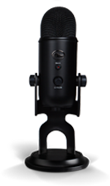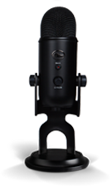The Blue Yeti vs AT2020 ongoing debate needs to be settled.
If you’re looking to record your music, create a podcast or simply record a video with better audio quality, these two microphones are popular choices.
Most Versatile
Blue Yeti
The Blue Yeti has a minimalistic design with volume and mute dials. It also has a port for the headphone Jack as well as for the USB cable.
Better Isolation
Audio-Technica AT2020
The AT2020 also has a simplistic design. It features a USB cable port together with Jack ports for headphones’ connectivity.
Contents
Which Is The Best Mic For You?
While they both have omnidirectional recording and USB connectivity, they have their differences as well.
However, both offer cardioid-mode microphones (plus stereo, omnidirectional, and bidirectional for the Blue Yeti).
This means they perform best when the users sit right in front of the microphone. Skype calls, podcasting, live streaming, and musical instrument recordings are the activities these microphones are optimized for.
In this AT2020 vs Blue Yeti guide, we’ll show you:
- Why the AT2020 is good for beginners
- What makes the Blue Yeti valuable for artists?
- Is the Blue Yeti worth the extra price?
The Specs
First let’s breakdown the technical info for both mics.
| Blue Yeti | AT2020 | |
|---|---|---|
| Microphone Type | Condenser | Condenser |
| Compatibility | Windows 7, 8.1, or 10, macOS 10.10 or higher | Windows 7, Vista, XP, 2000 and Mac OS X |
| Frequency Response | 20Hz-20kHz | 20Hz-20kHz |
| Polar Patterns | 4 | 1 |
| Condenser Capsules | 3 | 1 |
| Weight | Mic 1.2 lbs (.55 kg) w/ stand 2.2 lbs (1 kg) | 0.76 lbs (.35 kg) |
| More Specs & Reviews | Read more | Read more |

Audio Recording Versatility
Home users rarely rely on multiple microphones. This is why versatility is often crucial, especially for those recording various types of content.
Blue Yeti – covers most home recording needs
The Blue Yeti is impressive for its small package. Apart from the cardioid mode recording also present on the AT2020, the Yeti also records in an omnidirectional mode. This captures the sound equally from all directions.
Those who want to record a band or simply cover ambient noise better can use this feature successfully. The bidirectional recording is also possible.
Gamers who play at the same desk rely on such capabilities for their mic for live streaming their gaming. This capacity is also useful for podcasts where a host has an interviewee.
AT2020 – Sound isolation first
The microphone only records in the cardioid mode. This places the sound source directly in front of the microphone for the best audio quality.
Playing an instrument offers realistic sound reproduction with this type of recording.
Podcasters or those with online talk shows can also largely benefit from the capabilities of the microphone, even if it’s not as versatile as the Blue Yeti.
Portability: Ease of Changing Studio Setups
Having a microphone that can easily be moved from one place to another is seen as an advantage. If you need a different studio setup, easily moving tech from one place to another is crucial.
Blue Yeti – heavy but feature-packed
The microphone is very similar in performance to the AT2020. However, its 3 condenser capsules together with the thick materials make it considerably heavier.
This is not the microphone to take on vacations when you need to catch up on work assignments. The Blue Yeti weighs 2.2 lbs.
The heavier Blue Yeti is valuable in a general setup where there’s less need to move around. Fixed studio setups such as those Joe Rogan has are best for the microphone.
AT2020 – the lightweight option
While not as rugged, the Audio-Technica AT2020 wins the weight battle. Being considerably lighter with its 345 grams, it is also the option to consider for changing studio setup.
Those considering a daily podcast where décor changes all the time might find it easier to move around and even install at various angles.
Frequency Response
Frequency response offers a good insight into how sound is captured. Most valuable condenser microphones come with a 20Hz to 20kHz frequency range.
Blue Yeti – not too sensitive
The microphone offers a 20Hz to 20kHz frequency range. Its bass, low mids, mid-range, upper-mids, and highs are considered realistic.
With a maximum 120db sensitivity, the microphone is not as sensitive. The closer the sensitivity is to zero, the less sensitive a microphone is.
This is why the microphone works best as a general-purpose tool. Used for voice recording, it shines as it also offers impressive versatility.
AT2020 – the sensitive choice
With 90db sensitivity, the AT2020 is not as sensitive as the Blue Yeti. However, both microphones need to be secured on their stands to offer good sound without any vibration transmissions.
Since the Audio-Technica AT2020 is not as sensitive and since it also offers 20Hz to 20kHz sensitivity, it is recommended with song recordings. A good stand might also need to replace the desktop stand it comes with.

Blue Yeti: Differentiating Features
The Blue Yeti certainly has an advantage for recording modes. But it is also heavier and it is simply heavy to carry in a backpack.
Polar Patterns
There are 4 polar patterns offered by the Blue Yeti microphone. They are the cardioid mode, the omnidirectional mode, the bidirectional mode, and the stereo mode.
One of the biggest advantages of these modes is the dual-channel recording of the stereo mode.
It captures both left and right channels and it offers the listener a more realistic experience. This is highly useful in recordings where audio detail is important.
It is seen across the gaming industry where many listeners make full use of their premium headphones.
Volume and Mute Controls
Blue Yeti also differentiates itself with the 2 physical buttons on the microphone. The mute button cuts out the microphone, meaning users can pause or talk without their voice being recorded.
The button has applicability in live streaming where listeners don’t need to hear every word or where the host takes a break from commenting on an event.
A volume button is also added on the microphone. While volume can be set through various recording software, the button offers a faster method of controlling the recording’s volume right on the microphone.
This Might Interest You: AT2020 vs AT2035 comparison review
Audio-Technica AT2020: Differentiating Features
The AT2020 microphone holds its ground with sound performance even if it’s not as versatile as the Blue Yeti.
Headphone Volume Controls
Similarly to the Blue Yeti, the AT2020 also comes with a volume rocker. However, its role is to set the volume level of the headphones.
While recording, it allows the user to hear his or hears own voice at different levels in the headphone.
The role of the volume control is to ultimately improve the tone of voice while recording while offer in real-time feedback of how the final audio is going to sound like.
Full Set of Accessories
The Audio-Technica AT2020 comes with a pivoting desktop mount, a tripod, a threaded adapter, and a protective pouch.
It’s long 10’ USB cable completes the list of accessories. Practically, these accessories allow users to start recording with a basic setup right out of the box.
Yeti vs AT2020: Pros and Cons
Below is a breakdown of the good and the bad of each of these recording devices.
For a quick overview of the perks and downfalls read on and you’ll soon have an idea of which mic will work best for you.
Advantages of the Yeti
With its affordable price, the Blue Yeti is seen in many YouTube vlogs and even in TV studios. Its recording modes make it stand out in a crowded market.
- The Blue Yeti records omnidirectional sound which is recommended for those with multiple guests. Doing a Q&A session with the multiple guests in one scenario where this type of recording improves sound quality. Simply recording the video with the audio from a DSLR or compact camera is inferior to the omnidirectional Blue Yeti recording.
- The Blue Yeti records in the bidirectional mode in a more intimate space, there’s only room for one interviewee. In this case, the Blue Yeti has the distinct advantage of offering bidirectional recording. For many users, this means they don’t need fancy studio setups as their guests can sit right in front of them. It also means this type of recording enhances communication as it has been showing face-to-face communication is superior to other types of communication.
- The Blue Yeti is available in multiple colors. In the days of vlogging, looks matter and this applies to gear. This is why so many vloggers record studio tours where they go over their setups not only on how they perform but on how they look as well. Black, platinum, silver or Aztec copper are just a few colors the Blue Yeti is available in.
Disadvantages of the Yeti
Since there’s no perfect microphone, the Blue Yeti cannot be an exception. Its materials and polar patterns make it heavier than the AT2020.
- The Blue Yeti is heavy to travel with and even to move around in the studio. This is why users should expect a setup that is not too friendly with sensitive natural wood desktops. It’s also true that the right stand can make moving easier.
Advantages of the AT2020
With a sleek profile, some even argue the AT2020 is more elegant than the Yeti. Of course, design preferences vary for each individual.
- Audio-Technica AT2020 has a high dynamic range and low db sensitivity which means it’s ready for true audio performance, as long as the sound is captured right in front of the microphone. Without too many complications, it offers excellent frequency response.
Disadvantages of the AT2020
- The AT2020 is lightweight. This means vibrations are going to be transmitted to the microphone easier, especially with its original stand. However, this not a true disadvantage as its 12.1ozw weight makes the microphone easy to move around.
- There’s not too much versatility with the AT2020 in terms of directional recording. Furthermore, the microphone struggles to pick up proper sound in a group setting. Those who want to record a video where there’s a group of people talking might need to look towards the Blue Yeti instead.
Final Verdict
Both the Blue Yeti and the Audio-Technica AT2020 is among the best microphones users can hope for.
The Blue Yeti comes with USB compatibility while the AT2020 has an XLR version and a USB version. The frequency response is the same in both microphones.
The Blue Yeti has 3 cardioid capsules of 14 mm. The AT2020 has one 16mm diaphragm. For general purpose use such as one-man podcasts, users can’t go wrong with any of these microphones.
But when it comes to group settings or two directional recording, the Blue Yeti’s innovative triple capsule array might be worth the investment even considering it’s cheaper than the AT2020 (check price).






